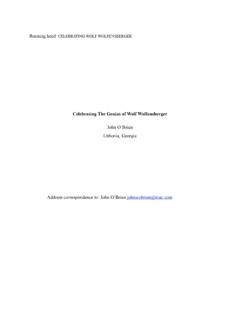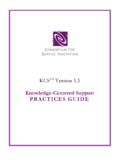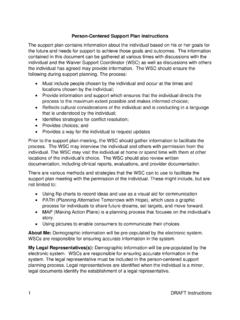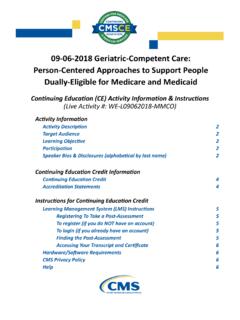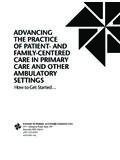Transcription of Person-Centered Planning and the Quest for System Change
1 Person-Centered Planning and the Quest for System Change 1. John O'Brien Approaches and Contexts ..3. Some Common Approaches to Person-Centered Planning ..3. Contexts and Functions for Person-Centered Planning ..6. What Person-Centered Planning Reveals About System Change ..9. Change Strategy 1: Adopt New Rules and Procedures for Individual Change Strategy 2: Use Person-Centered Planning In Service Reform ..13. Change Strategy 3: Person-Centered Planning Guides Purposeful Innovation ..16. Conclusion ..20. References ..21. 1 A version of this paper is published in Martin Agran, Fredda Brown, Carolyn Hughes, Carol Quirk, & Diane Ryndak, Eds.
2 (2013) Equity & full participation for individuals with severe disabilities. Baltimore: Paul Brookes. Person-Centered Planning & System Change 2. TASH2 advocates deep Change in typical service practice in its position statements on Community Living (2011) and Integrated Employment (2009). These statements, which are the most recent expressions of positions that reach back to the organization's early history, converge with The UN. Convention on the Rights of persons with Disabilities at Article 19 (Living Independently and Being Included in the Community), and Article 27 (Work and Employment), which adds the moral force of a world wide consensus of advocates, experts and politicians to the weight of international law in those nations who are party to the convention.
3 Article 19 provides the right to choose where and with whom one lives with the personal assistance necessary to support inclusion and prevent isolation or segregation from the community. Article 27 provides the right to an opportunity to gain a living by work freely chosen in a labor market that is open, inclusive and accessible. As of this writing the US has signed but not ratified the Convention; however, these two Articles are largely consistent with long-standing US policy. In this chapter, TASH values is shorthand for these two results: people live included in community life as occupants of their own homes and workers in integrated jobs.
4 Progress toward realizing these rights can be marked by steadily growing numbers of people with severe disabilities securely inhabiting their own homes and filling contributing roles in the life of our communities, especially by holding jobs in integrated settings. Available measures of the current performance of US services to adults with developmental disabilities show how far we have to go to make TASH values real. Fewer than 30% of people with developmental disabilities receiving residential support in the US in 2010 lived in a place they or another person with developmental disabilities owned or rented (states report a range from 2% to 85%) (Larson, et.)
5 Al, 2012) and 20% of all adults funded by US. developmental disability services were in integrated employment (states report a range from 5% to 88%). ( , 2012). As well, the Council on Quality and Leadership reports that only about a third of 7,800 interviewed as part of their accreditation process perform the social roles they desire in their communities (CQL, 2010). None of these accounts speak specifically to the experience of people with severe disabilities and none says anything about the quality of people's home or work life, but they indicate the distance that services must travel in order to approach TASH values.
6 (See chapter 15, Romer and Walker, for a description of the quality of the Person-Centered work required to support people to exercise choice in their home life). In this paper, the term System refers to the network of policies and practices concerned with assistance to people with severe disabilities. This network is reproduced and changed by the interaction of people with disabilities and their families and allies, advocacy groups, service providers, administrators charged with managing the availability and quality of services, and legislators and courts as they take an interest in policy and resources for people with disabilities.
7 Person-Centered Planning is one of many practices that each of these actors has adopted to Change the System . The US Centers for Medicaid and Medicare 2 TASH is an international organization that advocates for people with severe disabilities ( ). Person-Centered Planning & System Change 3. Services has promoted Person-Centered Planning in initiatives to shift the System 's balance of long term care from institutions to community services since at least 2001(NHPF, 2008). It has been central to policies aimed at transforming the System in England since 2000 (Routledge, Sanderson, & Greig, 2002).
8 This chapter reflects on the functions Person-Centered Planning has been assigned in System Change efforts, the impact it has had, and lessons some of its practitioners have learned. The paper first reviews approaches and contexts for Person-Centered Planning and then discusses what the implementation of Person-Centered Planning reveals about the work of deep Change when it is deployed as a part of three different Change strategies. Approaches and Contexts Person-Centered - Planning figures in many efforts to reform systems from New York to New South Wales. The effectiveness of Person-Centered Planning depends on the competence of facilitators, the adequacy of the match of a Planning approach to the situation and the context in which Planning is done.
9 Approaches The table below identifies nine of the most frequently used approaches to Person-Centered Planning . Though each approach has continually refined its practices over time, none is new (Lyle O'Brien &. O'Brien, 2002). TASH's 1991 account of critical issues included a chapter that drew on ten years experience of Person-Centered Planning , understood as the shared construction of stories that led to action for inclusion through an organized search for capacity and connection engaging people with developmental disabilities, their families and allies, and their communities (O'Brien & Mount, 1991).
10 Over time, and to varying degrees, services and systems have adapted some of these practices and incorporated them into their reform efforts, often labeling the result Person-Centered plans. Throughout this history some practitioners have facilitated Person-Centered plans outside formally organized services to assist people and families who want something different from what the System currently offers them. Sometimes these efforts at the edge of the System have opened better ways to realize TASH values. Some Common Approaches to Person-Centered Planning There are many reasonable approaches to Person-Centered Planning ; these are the most common and the most commonly adapted to fit other's styles and situations.
